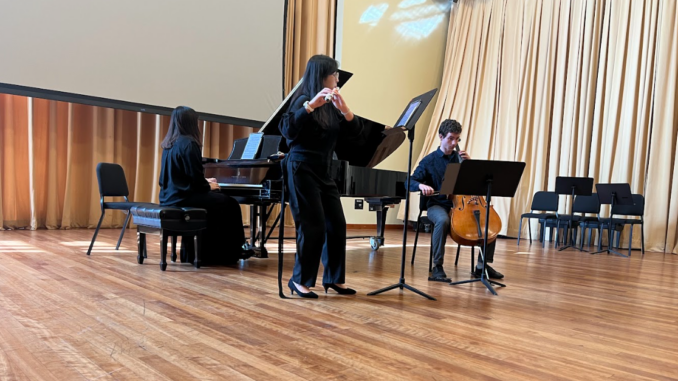
By Jaida Dent
The Brooklyn College Conservatory of Music opened the doors of the Topfer recital hall to welcome members of the community to its first “Afternoon Chamber Concert” of the semester on Thursday, Oct. 17. Coordinated by Professor Marianne Gythfeldt, students showcased their work and range of talents across four varying pieces.
Chamber music is a form of classical music that is composed for a small ensemble of performers. As opposed to being in a full orchestra, chamber music is meant to be intimate and to display the collaboration amongst performers, as each instrument has their own unique roles in the piece. The pieces reflected the value each instrument held in expressing the narrative of each piece.
The concert opened with Franz Schubert’s Violin Sonata No. 2 in A Minor, with Christopher DiVincenzo on violin and Nikita Tumanov on piano. The piece began with its first movement, Allegro moderato, greeting the audience members with a moderate and lively tempo. The remaining three movements were Andante (slow tempo, a walking pace), Menuetto (a moderate tempo one can dance to), and Allegro (fast and quick tempo), the rhythms of each reflecting the song’s growing speed over time. Across all four movements, the music constantly ebbed and flowed, and loud, dramatic parts were punctuated by a soft and graceful tempo.
The second piece presented was Joseph Hadyn’s Piano Trio No. 29 in G Major with Gloria Pan on the flute, Nathaniel Walcott on the cello, and Alice Tung on the piano. The ensemble played through the first two movements of this piece, Allegro and Andante. The first movement was lighthearted and airy as the musicians flitted across their instruments and the piano guided the piece as the flute and cello followed along. The second movement was much slower than the first, but still retained the airy quality.

The third piece was Mozart’s Clarinet Trio in E-flat Major, “Kegelstatt,” played by Patrick Holmes on clarinet, Lexi Lester-Williams on viola, and Jason Ruan on piano. Before playing, Ruan introduced the piece by sharing with the audience that “Kegelstatt” in German means “playground for skittles,” a game that was the predecessor for bowling. Each player in the game takes a turn, and as such the instruments echoed the back and forth nature of the game. The clarinet and viola had moments to shine through these turns.
The final piece was Antonín Dvořák’s Piano Quintet No. 2 in A Major, op. 81 played by Christopher DiVincenzo and Samuel Rodriguez on violin, Berthinna Valsaint on viola, Jacob Hernandez on cello, and Nikita Tumanov on piano. The musicians played the first movement of the piece, Allegro ma non Tanto, which from Italian translates to “fast, but not too much.” In some moments, the pace rapidly picked up in a rush, and in other moments, the music winded down in a graceful manner.
When the music picked up in tempo, the musicians would make rapid and jarring movements, indicating the intensity of the moment. Audience members had the chance to immerse themselves in the experience. Though only a few musicians played this piece, the production was a testament to the fact that an ensemble can be as powerful and moving as a full orchestra.
The Brooklyn College Conservatory has scheduled their next array of orchestral music for Nov. 5. For more information on shows and tickets, students can visit the BC Conservatory of Music on their Instagram, @bcmusic.nyc
